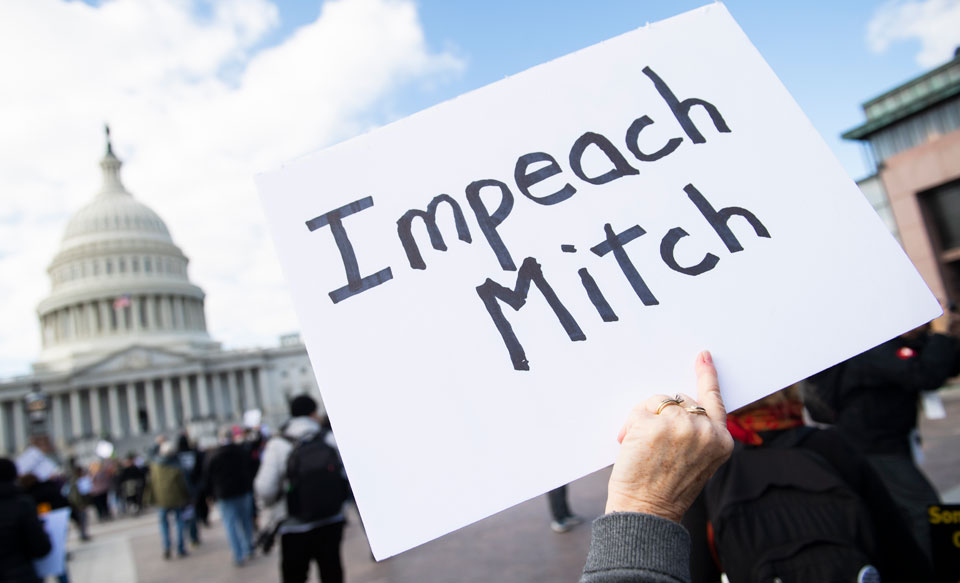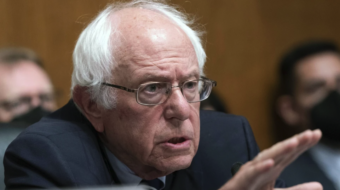
The nation is focused on the presidential race now as it has never before been focused on a presidential race. Yet another race, the race for control of the U.S. Senate, is equally critical to the future of democracy and economic justice in America.
If Biden wins, his agenda can be largely crippled if Republicans continue to control the Senate. If Trump wins, a Democratic Senate can prevent him from doing some of the worst he is capable of. A Democratic Senate can put an end to the brazen dismantling of democracy that the current GOP-controlled Senate has been carrying out. The criminal holding up of aid to a nation suffering under the pandemic and instead pushing through the confirmation of a right-wing justice on the Supreme Court is what we get from the Senate now. It’s a nightmare that must come to an end.
For the remaining days until Election Day, People’s World reporters will be writing about what is happening in the key races that will determine the makeup of the next Senate.

The importance of who controls the Senate cannot be overestimated. In addition to approving all legislation, the Senate has a lot to say about the makeup of the Cabinet, regardless of who wins the presidency. The current GOP-controlled Senate confirmed a Secretary of Labor who is anti-labor, an EPA chief who was a notorious corporate polluter, a Secretary of Education who attacks even the concept of public schools, and so many other Cabinet and agency chiefs devoted to Trump’s right-wing agenda. And, acting as the U.S. version of the House of Lords, they put three right-wing justices on the Supreme Court.
With Republicans holding a 53-47 majority, Democrats need to win back at least four seats—three, if they also win the White House since the vice president breaks 50-50 ties—for control of the Senate. They will also have to make up for the likely loss of Democratic Sen. Doug Jones in Alabama as they try to take over the Senate and replace Mitch McConnell with Chuck Schumer as Majority Leader.
The number of Senate seats the Democrats can pick up has increased as the popularity of Trump decreases, and the result is possible Democratic wins in states that have been considered “red” states until now.
Texas, Georgia, and even South Carolina are now places where Democrats can possibly pick up Senate seats. In each of those states, we are seeing massive voter mobilizations with a wide array of civil rights, labor, women’s, and other organizations participating in the campaigns.
Some of the Republicans running for re-election in those states are so worried about Trump’s sinking popularity that they are distancing themselves as much as they can from the president.
Nate Silver’s FiveThirtyEight.com is giving the Democrats a 73% chance of seizing control of the Senate, but no one is sure about this, nor are they predicting the size of the Democratic majority if they do win control. If it’s a 50-50 lineup, Kamala Harris would break a tie if Biden is president. If Trump wins, they will need 51 to have control. And 52, 53, or 54 would give them room to maneuver when there are close votes on controversial legislation.
While there are a dozen or so races that are tight and could go either way, there are half a dozen or so that Democratic and progressive allies in labor and elsewhere are focusing on with extra emphasis.
Arizona
Arizona is one of the targets. Democratic Rep. Kyrsten Sinema’s victory over GOP Rep. Martha McSally in the 2018 Senate race showed that the rapidly changing demographics in that state have opened opportunities to end the GOP grip on Senate representation coming from there.
McSally got in anyway, however, when the GOP governor appointed her to fill the seat of Sen. John McCain when he died. Her opponent, Mark Kelly, a former Navy captain and astronaut and husband of former Democratic Rep. Gabby Giffords, the gun control advocate so loved in that state, is doing well in the polls.
Colorado
In Colorado, there is a good chance of toppling Republican Sen. Cory Gardner, who was elected to the Senate in 2014 after a tsunami of corporate-funded attacks on the Obama administration for allegedly letting ISIS run rampant around the world.
Gardner finds himself now, however, running for re-election at a time when Trump is in trouble with Colorado voters for his failure to deal with the coronavirus pandemic.
Colorado has shed its Republican past even faster than Arizona. No Republican presidential candidate has won the state since 2004, and the Trump campaign has not even bothered to campaign there.
Maine
Another target for Democrats is Maine, where Sen. Susan Collins is slipping in her attempt to hold on as the last Republican senator in New England, a region that used to send lots of Republicans to the Senate. At one time, the Bushes were almost a royal family in the state of Maine.
Democrats have seized on Collins’s votes for Supreme Court Justice Brett Kavanaugh and to acquit the president in his impeachment trial, underlining her role as a supporter of the Trump agenda despite her occasional lip service opposition to his “style” and language. They see her as an enabler of Trump and his policies.
Her opponent, Democratic Maine House Speaker Sara Gideon, has outraised Collins with massive grassroots funding campaigns, and polls have Gideon ahead of the four-term Collins.
Iowa
At first, it was not thought possible, but now Iowa is also a target for the Democrats, even though Trump won that state by 10 points in 2016.
Republican Sen. Joni Ernst was elected in 2014 when she broke into the national media with a video of herself on a pig farm swearing to “make Washington squeal.” Now she is fighting for her political survival with Democrat Theresa Greenfield neck and neck with her in the polls.
Ernst is suffering because of her loyal support for Trump even as other Republicans put distance between themselves and the president. Trump’s polling in the state has now slipped slightly behind Biden’s.

North Carolina
Another target for the Democrats is North Carolina where Republican Sen. Tom Tillis is in a tight race for a second term against Cal Cunningham, a former Democratic state lawmaker and Army veteran. Polls have Tillis at 49% with 47% backing the Democratic challenger.
Tillis is tightly tied to Trump and cannot afford to lose any of Trump’s base. He is doing a balancing act on a tight rope he made for himself, telling voters that even if they don’t vote for Trump it is important to keep the Senate in GOP hands.
Reflecting his own fear that he could lose, he’s been telling voters that keeping the Senate in GOP hands would be “the best check on a Biden administration.”
His backing of Trump’s do-nothing approach to COVID really backfired on him in early October when, like the president, he became infected by the virus. It likely happened at the White House Rose Garden super-spreader party in honor of right-wing Justice-to-be Amy Coney Barrett, where he, like the others, was not wearing a mask.
Cunningham has his own problems, however, because he is being investigated by the Army Reserves, of which he is a member, for sending romantic text messages to a woman to whom he is not married.
Cunningham has been a vocal supporter of the Affordable Care Act and hopes to get a large vote in the cities and suburbs of North Carolina. Democrats don’t need North Carolina to capture the Senate majority, but their path becomes harder without it.
Michigan
Michigan Democrats are fighting more of a defensive battle to hold onto rather than take a Senate seat.
Democratic Sen. Gary Peters is seeking a second term but faces a strong challenge from Republican John James, an African-American former Apache combat helicopter pilot in Iraq. With a large African-American vote in Michigan, Republicans are hoping that Peters can capture enough of that vote, on top of the vote of Trump supporters, to put him rather than Peters in the Senate.
Peters is emphasizing James’s support for Trump on almost every single issue. Trump is running some 8 points behind Biden in the polls in Michigan, but the race between Peters and James is believed to be tighter.
James, who lost a Senate bid two years ago, has tried to cast Peters as “too liberal” for Michigan.
Surprise races now in play
There are a number of other surprises among Senate races that have become doable for Democrats, also because of the sinking popularity of the president.
Biden’s strong polling in so-called “red states” like Texas and Georgia has lifted Democrats’ chances in contests to unseat Sens. John Cornyn of Texas, and Kelly Loeffler and David Perdue in Georgia.
In Texas, M.J. Hegar has outraised Cornyn—and wiped out his cash advantage—and could benefit from massive early votes that have Republicans chewing their fingernails over the possibility of Texas going blue. Everyone remembers how in 2018 Beto O’Rourke almost toppled Ted Cruz in the Senate race.
In Georgia, Raphael Warnock, the pastor of Ebenezer Baptist Church, the church run by the Rev. Martin Luther King, Jr., is polling ahead of Loeffler, who is trying to hold off another right-winger, Rep. Doug Collins, in the crowded contest.
Jon Ossoff, a former Democratic House candidate, is also in a neck-and-neck contest with Perdue. The Republican Senator even tried to use a past People’s World article about Ossoff in an anti-communist smear attack.
Both races are likely to lead to runoffs with the top two finishers if no candidate secures at least 50% of the vote in November. That runoff would take place in January after the next Congress is already seated.
Then there is Trump sycophant Sen. Lindsey Graham, R-S.C., who is in a statistically tied race with Jaime Harrison, the former South Carolina Democratic Chair. Unprecedented voting by Black voters and young people in neighboring Georgia has lifted hopes for Harrison.

Reflecting Graham’s weakness, Vice President Mike Pence is planning to campaign in South Carolina ahead of the election.
In Alaska, GOP Sen. Dan Sullivan is challenged by independent Dr. Al Gross, who works closely with Democrats. Sullivan is on defense also because of his close alignment with Trump. Polling is close, and Gross is actually raising more money than Sullivan.
In Kansas, Republicans are worried about an open seat vacated by Sen. Pat Roberts. GOP Rep. Roger Marshall is running against Democratic state Sen. Barbara Bollier.
Bollier, a former doctor, is running in the polls only slightly behind the Republican.
Over the next several days, People’s World will take you in for a closer look at many of these critical races. They could make the difference in the direction the country takes after Election Day.
ELECTION 2020: Everything you need to know to vote in your state

MOST POPULAR TODAY


Zionist organizations leading campaign to stop ceasefire resolutions in D.C. area

High Court essentially bans demonstrations, freedom of assembly in Deep South

Afghanistan’s socialist years: The promising future killed off by U.S. imperialism

Communist Karol Cariola elected president of Chile’s legislature






Comments